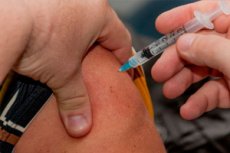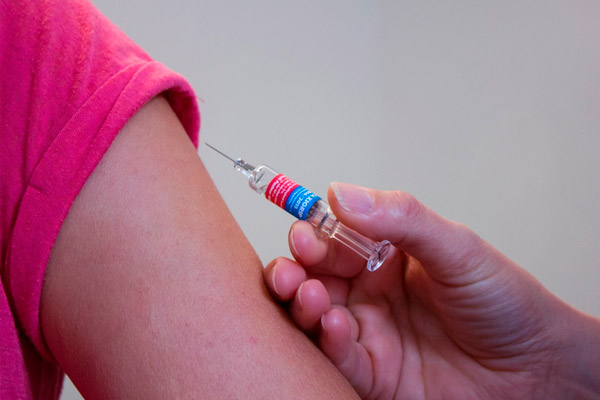Inoculation from cervical cancer
Last reviewed: 27.01.2025

All iLive content is medically reviewed or fact checked to ensure as much factual accuracy as possible.
We have strict sourcing guidelines and only link to reputable media sites, academic research institutions and, whenever possible, medically peer reviewed studies. Note that the numbers in parentheses ([1], [2], etc.) are clickable links to these studies.
If you feel that any of our content is inaccurate, out-of-date, or otherwise questionable, please select it and press Ctrl + Enter.

Vaccination against cervical cancer is a vaccine that prevents infection with a dangerous human papillomavirus. In our time, medicine is aware of a large number of types of HPV (about 100), causing the development of various diseases. In 70% of women, this virus is considered the main cause of oncology, including cervical cancer. The emergence of a malignant tumor is provoked by about 15 types of HPV, of which the 16th and 18th types are the most oncogenic.
The basis of vaccines is a particle that does not contain a genome and consists only of the envelope of the virus. By itself, it can not cause the development of the disease or provoke its aggravation, but it forms a stable immunity to all oncogenic types of HPV. It should be noted the importance of such a preventive measure, because often even the application of the most innovative methods of treatment of a malignant tumor does not give the desired result, which leads to a fatal outcome. Therefore, it is better to prevent the disease by vaccination, which prevents infection, which doctors recommend to girls aged 12 years.
Where can I get an inoculation against cervical cancer?
Vaccination from cervical cancer is able to reliably protect the body of a woman from a dangerous human papilloma virus, which provokes the development of many diseases.
Many women are interested in the question of where to vaccinate against cervical cancer? It should be noted that both vaccines used for this purpose - "Cervarix" and "Gardasil" - are imported, which affects their price. There are no domestic analogues of these drugs at the moment. A vaccine against HPV can be obtained at the gynecological department of a medical facility where these vaccines are available. This method is convenient because in one hospital it is possible to undergo examination (examination by a gynecologist), give a smear to cytology and make a vaccination.
Private clinics may also have vaccines to prevent the development of cervical cancer. If you want, you can also get an inoculation there, having previously specified the cost of this procedure. It can be much higher, which is due to the price policy of each individual medical institution.
In addition to the above options, vaccination against cervical cancer can be done in the vaccine center of the city or the immunology department of the medical institution. Only proven vaccines are used here, and the rules for storing drugs are strictly observed. By the way, vaccination centers and many private clinics offer a special service for vaccination at home. In this case, a team of doctors will come to your house, a qualified doctor will conduct an examination and, according to its results, will allow or forbid vaccination. If vaccination is carried out, medical specialists will follow your condition for half an hour to provide quick help in case of an allergic reaction. The method of inoculation at home is considered the most optimal. In this case, contacts with other people are minimized, which excludes the possibility of infection with an infection or an influenza virus. Other advantages of this method include the convenience and maximum attention of physicians.
When to inoculate against cervical cancer?
Many women are interested in the question of when to inoculate against cervical cancer. Those. What is the optimal age for this? First of all, it should be noted that such vaccination is recommended by doctors, but it is not an obligatory measure of prevention.
Vaccination against cervical cancer is recommended to girls (starting from the age of 12), as well as to young women under the age of 25 (ie, vaccination should be carried out before the onset of sexual relations and possible infection with HPV). Unfortunately, the vaccine will not work if there is a virus in the body. It should be emphasized that papillomavirus is not the only cause of cervical cancer. Therefore, vaccination does not give 100% guarantee that the disease can be avoided.
The best age period for receiving this vaccine is 15-17 years, when the girl's body is formed, and puberty is almost over. Young women who have an active sex life should undergo a diagnostic examination to identify the human papillomavirus and a clear definition of its type. For this purpose, the PCR method is used (sampling of the smear (biomaterial) from the vagina and cervix). Before vaccination it is necessary to consult a doctor about the contraindications of this procedure, as well as side effects, including the possibility of allergic reactions. The choice of the drug remains for the woman, as well as the decision to vaccinate itself.
Where do they get an inoculation against cervical cancer?
Vaccination against cervical cancer reliably protects the body from the most dangerous (oncogenic) types of HPV and is considered a recombinant vaccine, i.e. This preparation contains not genetic material of papillomavirus, but only antigens of protein nature.
Many women are interested in the question of where they are being vaccinated against cervical cancer? Based on the composition of the drug, the optimal method of injection is determined - intramuscular. Since recombinant vaccines are characterized by low reactogenicity, they contain aluminum hydroxide. It enhances the effect of immunity in response to the ingestion of active graft elements into the blood, while simultaneously performing two functions. The first is the active adsorption of antigens of protein nature, and the second - in causing an inflammatory reaction at the site of administration of the drug. That is why the most correct place for injection will be a part of the body with developed muscle tissue, i.e. Hip or shoulder.

With the introduction of the drug, it is important to get directly into the muscle, - so the vaccine will enter the blood at the maximum speed, providing the formation of special antibodies to protect against HPV. The exposure of the vaccine to the fatty layer or skin provokes a low release rate, which means that the active particles are destroyed and the inoculation is ineffective.
The introduction of the vaccine into one of the buttocks is prohibited, since it can cause various complications, for example, traumatizing the sciatic nerve with a needle from the syringe. The ineffectiveness of such vaccination is due to the deep occurrence of muscle fibers in the buttock.
Names of vaccinations
The vaccine against cervical cancer protects against the main pathogen of the disease - papillomavirus. Statistics show that in our time, this virus has infected up to 60% of women all over the world. It is not surprising that this diagnosis ranks third among the most common oncological diseases.
The names of vaccinations against HPV, which are used in modern medicine - "Gardasil" (American drug) and "Cervarix" (Belgian vaccine). Both vaccines are administered once in a lifetime. Their effective action aimed at preventing the development of malignant tumors has been proven.
"Gardasil" refers to the group of mandatory vaccinations in the US and Australia - it is administered to all girls who reached 11-13 years of age. This vaccine contains components from 4 types of HPV - 6, 11, 16 and 18. "Cervarix" protects only 2 types of HPV - 16 and 18.

As active components, the vaccines contain only parts of the HPV protein envelope, which guarantees their complete safety from the point of infection. Excipients are aluminum hydroxide, yeast elements, preservatives and antibacterial agents. Vaccines are available in the form of suspensions ready for use and poured into vials or disposable syringes with an accurate dosage of the drug. In general, it is necessary to introduce three doses according to certain schemes. The optimal temperature for storage of vaccines is 2-8 ° C. Vaccines can not be replaced or alternated; In the course of inoculation, consisting of 3 doses, the same drug should be used.
Complications after vaccination
The vaccination against cervical cancer is absolutely safe and does not cause any serious side effects.
Complications after vaccination are manifested in the form of a local reaction - redness, painful sensations, swelling, a slight sensation of itching. Such symptoms do not require special treatment and go on their own for a couple of days. If part of the vaccine has entered the subcutaneous fat layer, and not into the muscle, a seal or cone may occur at the injection site. Do not worry, even if the resorption time will take several weeks.
In addition to local reactions, vaccination can cause minor common symptoms: malaise, headache, fever (maximum - 38 ° C), weakness. These signs can be observed for several days. High temperature can be brought down by antipyretic drugs (Paracetamol, Ibuprofen, Naise, etc.). With a tendency to allergic reactions, the vaccine is done against the background of taking antihistamines 2-3 generations (Fenistil, Erius, etc.), which do not provoke dryness of the mucous membranes.
The vaccination against cervical cancer is now considered one of the most effective preventive measures and is widely used in many countries of the world.


 [
[